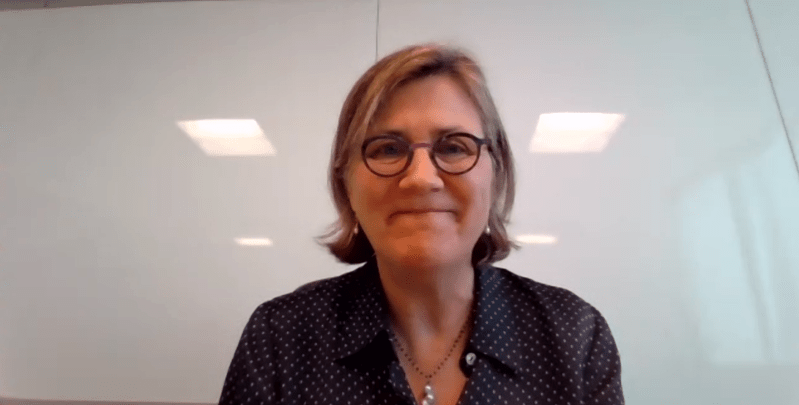Santa Clara County health officer and public health director Sara Cody ’85 was awarded the Stanford public policy program’s Zale Lecture and Award for Public Service on Tuesday. During her acceptance speech, Cody discussed her role at the forefront of the Bay Area’s COVID-19 response, explaining that extending shelter-in-place orders was meant to prioritize equity and stressing the importance of working alongside community leaders.
Cody ordered the country’s first local shelter-in-place order in March 2020, alongside other Bay Area officials.
“It was the only way that we knew at the time to protect communities that were going to be disproportionately affected,” she said, pointing to those working high-exposure jobs at nursing homes, public transit or grocery stores who often have multi-generational families with elders living in the same household.
Working with community leaders was especially important when implementing a testing and vaccination strategy, Cody said. In Santa Clara County, 76.2% of residents 12 and older have had at least one dose of the COVID-19 vaccine, and 63.5% are fully vaccinated, according to Cody.
However, she acknowledged that the vaccination rates are uneven across different populations — a disparity that falls hardest on minority and low-income people. She pointed to access, transportation and work schedules as some of the barriers to higher vaccination rates in marginalized communities and suggested bringing mobile vaccination units into familiar communities on weekends and evenings to help.
The lowest vaccination rates are among Latinos and African Americans, which Cody said she believes has more to do with many generations of historic distrust of government than with the logistics of accessing a vaccine. She said since vaccine demand has dropped off since April, it’s most important that the people who promote the vaccine in underserved areas are “from the community” and “can share their experience.”
Over the past year, and especially as vaccination rates have climbed and cases have dropped, Santa Clara County has worked to gradually lift restrictions, beginning with relaxing outdoor regulations in response to emerging evidence about outdoor transmission last June and shifting resources from restrictions to vaccinations later in December.
“We wanted to ease up enough to allow the most activity that could be allowed without bumping up the cases, because once the case count starts bumping up, you can risk getting into an exponential growth again,” she said.
Reopening schools also remained a priority from the beginning, Cody said, explaining that “we really wanted was to have everything else wound down and have the only activity be in-person education.” Most schools in the county partially or fully reopened by the end of March 2021.
Just over a year earlier, Santa Clara County had been one of the first jurisdictions to see cases. The county’s decision to limit gatherings in early March of 2020 felt like an “enormously big deal,” especially given the fear of frightening the public.
However, she felt the biggest decision she made was to issue a shelter-in-place order alongside her colleagues in the Bay Area.
“It was very clear at that point that we were in enormous trouble,” she said, explaining that at that point there were very few tools such as testing, contact tracing and personal protective equipment available to protect the public.
The unique relationship between Bay Area health officers allowed them to make a decision quickly. Many of the officers are part of the Association of Bay Area Health Officials, which assembled in the 1980s to address the AIDS and HIV epidemic. Since then, they have stayed in touch, getting together every month or two for dinner during non-COVID times.
“If we hadn’t known each other and spent years building relationships and building trust, we never could have moved that quickly,” she said. “There was no playbook and there was no plan for issuing a shelter-in-place order.”
The governance structure of Santa Clara County also placed Cody in a unique position: Here, health officers report to the county executive rather than directly to elected politicians. She said this gave her a “level of protection and support” she didn’t feel other public health officers had.
Many health officers who made unpopular decisions and did answer to elected politicians were forced to resign or were fired because of the “very political and very passionate” nature of the pandemic. Nonetheless, Cody said she felt able to stick to the subject matter expertise.
That expertise began during Cody’s time at Stanford. In undergrad, she majored in human biology, concentrating in the political, economic and social determinants of healthcare delivery. Her academic focus allowed her to look at public health problems from many different dimensions — a background she credits with her motivations for entering public service. She also spoke to her experience on the undergraduate club rowing team, likening her ability to stick with the sport despite being far out of her comfort zone to handling the pandemic.
Cody said she rediscovered her love for public health during medical school and residency, eventually taking the Epidemic Intelligence Service fellowship with the Centers for Disease Control and Prevention, where she spent time investigating infectious disease outbreaks.
As far as how Cody’s role will evolve as the pandemic begins winding down, she said the next challenge will be addressing a workforce that is burnt out from long hours and trauma.
“I am starting to turn my attention to putting the department back together again, but I would say I’m still probably 80% focused on COVID,” she said.
